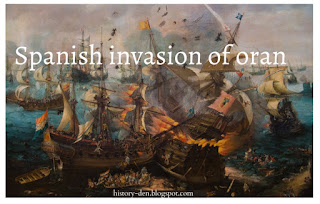North Africa had long been a power strugglebetween the Europeans and native states, or Ottoman vassals. The Spanish and Portuguese had long held anumber of cities within North Africa, largely for future colonization that the discoveryof the new world put on hold. Many wars and battles would be waged overthese cities, and in today's episode. We will be covering one of those conflicts. The 1732, Spanish Invasion of Oran. During the multi year long War of Spanish Succession.
The Spanish cities of Oran and Mers El K bir,which had been longtime Spanish strongholds in North Africa, were finally re-taken bythe Beylik of Mascara in 1708, ending over two centuries of European control in the region. With the war of succession ended, and withthe resurgence of the new Spain, King Philip V, organized an expedition to recoup the lost cities, paid largely via threatening the Republic of Genoa in 1726 to either pay 2 million paso's,or have the city be bomb into oblivion. Of the 2 million given to the Spanish, 1.5million would be set aside for this expedition, and by 1728, the beginnings of the plans wereset into motion.
The Spanish fleet would start to be assembledin the city of Alicante at the start of 1732, headed by the Duke of Montemar, Jos Carrillode Albornoz. The preparation of the expedition nearly causedthe ruin of Alicante, as the town was largely supplied from the port, and most of what camein was automatically given towards the expedition. But, after months of planning, gathering of men, supplies, and ships. The invasion fleet would finally set sail. It's eyes on the city of Oran. Making up this grand fleet would be 12 shipsof the line, each of them packing 60 or 74 guns. 50 frigates, packing 32 or 40 guns, 26 halfgalleys with six guns each, 96 Xebec vessels, acting as both troop and supply vessels. 109 troop Transport vessels, Plus hundredsmore craft that included a combination of Brigs, Galleys, Bomb Vessels, mortar boats,and others. The army itself, was split into 32 infantry battalions, twelve royal guard regiments, and a company of Oranian riflemen, Amountingto 23,000 men. Aiding them, would be 3,400 cavalrymen, splitinto 8 regiments, as well as an artillery battalion which boasted 60 guns and 20 mortars.
Mustapha Bouchelaghem the Dey of Algeris,had received advanced warning of the Spanish invasion and gathered his forces for theireventual arrival. With him, would be his militia forces amountingto roughly 9,000 men, 1,500 of them being mounted tribal warriors. Most of the men were poorly if trained atall, and most were poorly equipped, many having firearms dating back decades if not hundredsof years, or were armed with swords and bows as their only offensive capability. At the center of the army, and acting as itshardened core however, were 150 Ottoman Janissaries with relatively modern equipment, includinga small contingent of modern artillery, numbering ten pieces.
Supporting the Dey, would be allied troopsnumbering 1,500 Turkish regulars and 5,000 horsemen from the Kingdom of Fez. The Ottomans themselves would send 2,000 Jannisarriesfrom Constantinople to aid as well, but neither force was present during the invasion. The Dey would be left with his out numberedand out equipped forces to fend off the Spanish. On June the 27th, the Spanish would arriveoff the coast, landing just to the east of Mers el-Kebir. The landing was not heavily opposed, and only skirmishers, consisting of light Algerian Calvary would engage the Spanish, slowingthem down on their advance towards the city. At a location between the two cities, theSpanish would set about building a small fort from where to launch their invasions from.
The Algerians would attack multiple timesat the encampment, but would be repulsed time and time again. With his force split between three locations,the Dey know that he didn't have the ability to stop the Spanish. Instead, he decided that the best course ofaction was to consolidate his forces, harass the invading troops as best as he could, andawait reinforcements. The Spanish would reach the gates of Mersel-Kebir on July the first, defending the city, was the 150 janissaries that the Deyhad at his command, the rest of the men having been transferred out from the city, and takingup positions with the rest of the army in the mountain pass. The Spanish would put the city under siege,but the Janissaries surrendered on the same day, on the condition that they would be allowedto leave Algeria and return home. Albornoz, hearing that the Dey's troops wereon the move, quickly advanced with 7,000 men towards the nearby mountains where he knewthe bulk of the Algerian army was. Caught off guard by the sudden advance. The Algerian army scattered, some re-grouping in Oran itself, while many others simply laid down their arms and returned home.
His forces now scattered and weakened even more, the Dey pulled all his troops out from Oran, knowing that defending it was not possible,and the Spanish would occupy the city on July the 5th. This wouldn't be the last of the Dey's attempts however. In August, after Montemar had left North Africa,with a garrison of 8,000 troops in the cities. The Dey, now reinforced with the Fezian troops and Ottoman reinforcements, would attempt to take Oran again. With 10,000 men he'd advance on the city,but ultimately would fail. Losing 2,000 men to the Spanish's 500. While he would continue to prob the city for the rest of the year, he never had the manpower to dislodge the garrisoned troops, and he'dultimately admit defeat and send the rest of his men back home. Leaving Spain once again with the Algeria Footholds. Yet, Spain would not forget of this war. And years later, they would once again comeback in force to try and pacify Algeria, leading to one of the largest disasters ever to facethe Spanish army. But, that is a topic, for another time.





0 Comments
Post a Comment